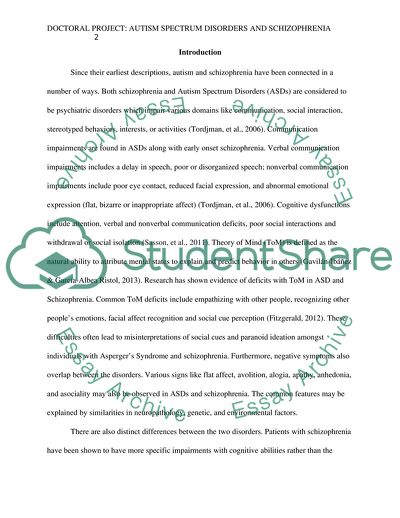Cite this document
(Autism Spectrum Disorders and Schizophrenia Research Paper Example | Topics and Well Written Essays - 5000 words, n.d.)
Autism Spectrum Disorders and Schizophrenia Research Paper Example | Topics and Well Written Essays - 5000 words. https://studentshare.org/health-sciences-medicine/1815393-autism-spectrum-disorders-and-schizophrenia-co-morbidity-neuropsychological-genetic-and-environmental-factors-and-implications-for-treatment
Autism Spectrum Disorders and Schizophrenia Research Paper Example | Topics and Well Written Essays - 5000 words. https://studentshare.org/health-sciences-medicine/1815393-autism-spectrum-disorders-and-schizophrenia-co-morbidity-neuropsychological-genetic-and-environmental-factors-and-implications-for-treatment
(Autism Spectrum Disorders and Schizophrenia Research Paper Example | Topics and Well Written Essays - 5000 Words)
Autism Spectrum Disorders and Schizophrenia Research Paper Example | Topics and Well Written Essays - 5000 Words. https://studentshare.org/health-sciences-medicine/1815393-autism-spectrum-disorders-and-schizophrenia-co-morbidity-neuropsychological-genetic-and-environmental-factors-and-implications-for-treatment.
Autism Spectrum Disorders and Schizophrenia Research Paper Example | Topics and Well Written Essays - 5000 Words. https://studentshare.org/health-sciences-medicine/1815393-autism-spectrum-disorders-and-schizophrenia-co-morbidity-neuropsychological-genetic-and-environmental-factors-and-implications-for-treatment.
“Autism Spectrum Disorders and Schizophrenia Research Paper Example | Topics and Well Written Essays - 5000 Words”. https://studentshare.org/health-sciences-medicine/1815393-autism-spectrum-disorders-and-schizophrenia-co-morbidity-neuropsychological-genetic-and-environmental-factors-and-implications-for-treatment.


